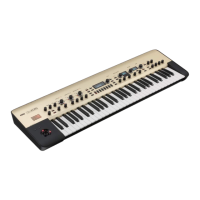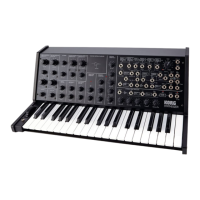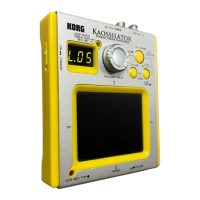-
7 -
KingKORG Parameter Guide Parameters
Unison oscillator
Detune
OSC D
OSC C
OSC B
OSC A
OSC E
These oscillator types stack five oscillators, each outputting a basic waveform,
and mix the output.
You can create thick, rich sounds by playing just a single note.
If you’ve selected a unison oscillator, CONTROL 2 is not available.
013: Unison Saw
Outputs two sawtooth waves.
014: Unison Squ.
Outputs two square waves.
015: Unison Tri.
Outputs two triangle waves.
016: Unison Sine
Outputs sine waves.
CONTROL1: Detune ..................................................... [000…127]
This detunes the pitch of the five oscillators.
Increasing this value will broaden the pitch difference between the oscillators,
creating a thicker sound.
Sync oscillator
Mod Pitch
OSC B
OSC A
Phase Reset
Mod Pitch = 0
Mod Pitch = 8
Mod Pitch = 47
These oscillator types forcibly reset the phase of the oscillator B waveform
(slave) at each cycle of the oscillator A (master) waveform, producing a
distinctive overtone structure.
If you’ve selected a sync oscillator, CONTROL 2 is not available.
017: Sync Saw
Outputs a modulated sawtooth wave.
018: Sync Square
Outputs a modulated square wave.
019: Sync Tri.
Outputs a modulated triangle wave.
020: Sync Sine
Outputs a modulated sine wave.
CONTROL1: Mod Pitch ................................................[000…127]
This adjusts the pitch of oscillator B (slave waveform).
A setting of “32” is +1 octave, and a setting of “64” is +2 octaves.
Ring oscillator
Mod Pitch
OSC B
OSC A
RING MOD
These oscillator types multiply waveforms of differing frequencies, adding sum
and difference overtones that do not exist in the original sound.
You can use these to produce bell-like or metallic sounds.
If you’ve selected a ring oscillator, CONTROL 2 is not available.
021: Ring Saw
Multiplies a sawtooth wave by another sawtooth wave, and outputs the result.
022: Ring Square
Multiplies a square wave by another square wave, and outputs the result.
023: Ring Tri.
Multiplies a triangle wave by another triangle wave, and outputs the result.
024: Ring Sine
Multiplies a sine wave by another sine wave, and outputs the result.
CONTROL1: Mod Pitch ................................................[–63…+63]
This adjusts the pitch of oscillator B (modulator).
Settings of “±48” correspond to ±1 octave; at a setting of “+00” the pitch will be
the same as oscillator A.
Cross modulation oscillator
Mod Pitch
OSC B
OSC A
Mod Depth
CROSS MOD
These oscillator types use the output waveform of oscillator B (modulator) to
modulate the frequency of oscillator A (carrier), producing a complex overtone
structure. This lets you apply modulation at a higher frequency than an LFO.
025: XMod Saw
Outputs a modulated sawtooth wave.
026: XMod Square
Outputs a modulated square wave.
027: XMod Tri.
Outputs a modulated triangle wave.
028: XMod Sine
Outputs a modulated sine wave.
CONTROL1: Mod Depth ...............................................[000...127]
This adjusts the depth of cross modulation.
CONTROL2: Mod Pitch .................................................[–63...+63]
This adjusts the pitch of oscillator B (modulator).
Settings of “±63” correspond to ±2 octaves, settings of “±48” correspond to ±1
octave, and “+00” is the same pitch as oscillator 1.
Variable phase modulation oscillator
Mod Harmonics
OSC B
OSC A
Mod Depth
VPM
These oscillator types use the output waveform of oscillator B (modulator) to
modulate the phase of oscillator A (carrier), producing a complex overtone
structure.
This lets you apply modulation at a higher frequency than an LFO. Unlike
cross modulation, OSC B will modulate the phase at precise integer multiple
frequencies (Mod Harmonics) of OSC A, and therefore pulsing will not occur in
the waveform.
